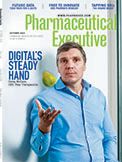Surfing the Wave: The Patient-Data Puzzle
Pharmaceutical Executive
While commercial websites can employ analytics to gain better snapshots of their visitors, pharma faces far greater challenges in using technology as a way to track and understand its consumers.
As technology continues to rapidly evolve, opportunities for pharma also increase when it comes to patient data. While commercial websites can easily employ analytics garnered from their sites to gain a better snapshot of their visitors, pharma faces far greater challenges in using technology as a way to track and understand its consumers.
The existence of information is not a problem for pharma. Data collected from sources such as electronic health records, clinical trials, virtual registries, big health systems, and wearables abound. The challenge is in how to gather the data, access it, and process it.
Gathering data
When it comes to targeted medicine, many drugs often are approved with the regulatory requirement to provide further monitoring in regard to safety. As a result, an increased amount of data is needed. Two of the biggest commercial data collection pieces in the market are these safety signals being driven by FDA and outcomes data being driven by payers.
“The market moves the most from FDA guidance, so that’s going to be where most of the data grows-around
Shane Senior

regulatory, pharmacovigilance, registries, and Phase IV trials,” says Shane Senior, co-founder and managing director of Crosstree. “As we move into value-based contracting, in order to get paid, you have to track data to prove your outcomes-that you’ve made a positive impact on patient outcomes.”
Pharma companies can rely on third-party vendors to set up registries or data collection, or they can pay to do it themselves. They usually hire a contract research organization (CRO) to set up Phase IV studies, then the CRO contracts with sites to garner data.
“Most pharma companies are going to outsource this,” says Senior. “I think that because of the specialization of these trials-the specialized vendors in the market are going to get it right first. I think they are going to have advantages in finding better solutions over CROs.”
Accessing data
Privacy is another major issue when it comes to capitalizing on patient data. Due to the personal nature of healthcare, much of the data gathered is sensitive, and patients may not want to share it.
“It’s a problem,” says Senior. “Ten years ago, nobody was thinking of this, and there was no consent asked of the patients. The big health systems are going to have a challenge: Do they license this data to a large pharmaceutical company that’s going to gain insights from it for proprietary medicine? Do they license the data to third-party providers? And what are they doing with this data that patients never signed off on? In the world of Facebook and data-breach issues, I think there are some healthcare providers that are going to be reluctant to do that.”
Additionally, as patients have the right to refuse sharing their data, it may become challenging to obtain important longitudinal data that provides a more well-rounded picture of the patient.
Processing data
With so much data available, pharma is just beginning to see the potential of big data.
“If you have a gene profile across 20,000 patients, that’s one data point,” says Senior. “But if you had those 20,000 patients and their health history, [that’s something else]. Think of the gene profile as one puzzle piece and a patient’s health history as one puzzle. If you have 5,000 puzzles or 20,000 puzzle pieces, there are different levels of value in both those data sets. But, ultimately, the puzzles-not the puzzle pieces-are where we’re going to end up with the most valuable data and the most informed insights. It’s going to be a key piece in solving some disease states.”
Not all companies can jump fearlessly into the world of big data and its big promises, though. For those wanting to capitalize on it, it can require hundreds of millions of dollars in investment.
“Small, undercapitalized companies [should be] wary of pursuing big data,” says Senior. “The most prevalent mistake we see is companies underestimating the cost to get to scale. So data solutions that are more drug-focused, more project-focused are going to get to a value proposition that can be commercialized faster with less capital.”
Some companies obtain data from big health systems and add value to it across multiple data points. For example, Cerescan takes imaging data of Alzheimer’s disease patients and enhances it to provide a richer

picture. The machine learning improves the diagnostics around the Alzheimer’s indication, and then the company combines that data with health records and patient history.
“So it’s not just a database of images, of puzzles pieces,” says Senior. “It’s a database of puzzles, because you have the entire view of the patient. Cota [Healthcare] is doing something similar in oncology.”
In order to digest all this data into usable information, companies rely on analytics, from technology platforms that weave data together to big data subscriptions that sell a platform along with data. Additionally, there are service providers that can license data from a turnkey analytics provider and help the pharma company interpret data and make commercial decisions.
As pharma continues to expand into precision medicine, patient engagement will become very specific. Ten years ago, 75% of approved drugs were traditional medicines. In 2018, that number was only about 33%, indicating that two-thirds of approved drugs last year were specialty, rare, or precision.
“As we move into precision medicine, patients are going to be easier to find,” says Senior. “It’s not finding the patients; it’s stratifying the patients and getting the right medicine to the different stratifications [that will be important]. And then, like in gene therapy, matching the mutations of a patient’s condition and correlating that to the available drugs to give the patients the highest chance of success. That’s the market we’re in.”
Elaine Quilici is Pharm Exec’s Senior Editor. She can be reached at equilici@mmhgroup.com

Addressing Disparities in Psoriasis Trials: Takeda's Strategies for Inclusivity in Clinical Research
April 14th 2025LaShell Robinson, Head of Global Feasibility and Trial Equity at Takeda, speaks about the company's strategies to engage patients in underrepresented populations in its phase III psoriasis trials.
Is Artificial Intelligence a ‘Product’? Products Liability Implications for AI-Based Products
April 10th 2025As the physical products we use evolve to become increasingly complex, traditional products liability frameworks may not always fit to provide remedies for harm that can result from using novel product types.